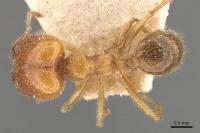Pheidole godmani
| Pheidole godmani | |
|---|---|

| |
| Scientific classification | |
| Kingdom: | Animalia |
| Phylum: | Arthropoda |
| Class: | Insecta |
| Order: | Hymenoptera |
| Family: | Formicidae |
| Subfamily: | Myrmicinae |
| Tribe: | Attini |
| Genus: | Pheidole |
| Species: | P. godmani |
| Binomial name | |
| Pheidole godmani Forel, 1893 | |
P. godmani was found near streams in mountain forest at 460 m. One colony was discovered nesting beneath dead leaves, a second in soil under a log. (Wilson 2003)
Identification
See the description in the nomenclature section.
Keys including this Species
Distribution
Known from St. Vincent. This species, with its nearest known relatives in South America, may be an endemic of the island. If so, it is a threatened species; H. H. Smith, whose collecting on St. Vincent in the 1890s was notably thorough, found it only three times. (Wilson 2003)
Distribution based on Regional Taxon Lists
Neotropical Region: Lesser Antilles, St. Vincent.
Distribution based on AntMaps
Distribution based on AntWeb specimens
Check data from AntWeb
Countries Occupied
| Number of countries occupied by this species based on AntWiki Regional Taxon Lists. In general, fewer countries occupied indicates a narrower range, while more countries indicates a more widespread species. |

|
Estimated Abundance
| Relative abundance based on number of AntMaps records per species (this species within the purple bar). Fewer records (to the left) indicates a less abundant/encountered species while more records (to the right) indicates more abundant/encountered species. |

|
Biology
Castes
Worker
Minor
Images from AntWeb
   
| |
| Paralectotype of Pheidole godmani. Worker. Specimen code casent0908165. Photographer Will Ericson, uploaded by California Academy of Sciences. | Owned by MHNG, Geneva, Switzerland. |
Nomenclature
The following information is derived from Barry Bolton's Online Catalogue of the Ants of the World.
- godmani. Pheidole godmani Forel, 1893g: 404 (s.w.q.) ANTILLES. See also: Wilson, 2003: 698.
Unless otherwise noted the text for the remainder of this section is reported from the publication that includes the original description.
Description
DIAGNOSIS From Wilson (2003): A member of the tristis group, similar to Pheidole balzani, Pheidole gaigei and Pheidole huilana, and to lesser degree the species listed with them, distinguished as follows.
Major: reddish yellow; low, lobose subpostpetiolar process present; antennal scape short, its tip reaching the lateral border of the head in full-face view less than half the distance from eye to occipital corner; postpetiole from above cone-shaped; carinulae of head reaching two-thirds the distance from eye to occipital corner; humerus prominent, lobose, in dorsal-oblique view extending well above the low mesonotal convexity.
Minor: all of posterior dorsum of head and of entire dorsum of promesonotum transversely carinulate; semicircular carinulae fill the space between the antennal fossa and the eye.
MEASUREMENTS (mm) Lectotype major: HW 1.44, HL 1.52, SL 0.82, EL 0.14, PW 0.64. Paralectotype minor: HW 0.62, HL 0.66, SL 0.72, EL 0.12, PW 0.42.
COLOR Major: head and body light reddish yellow, except for postpetiole and gaster, which are medium reddish yellow with a brownish tinge.
Minor: head and mesosoma medium yellowish brown; waist, gaster, and appendages a slightly contrasting light yellowish brown.
Figure. Upper: lectotype, major. Lower: paralectotype, minor. Scale bars = 1 mm.
Type Material
Musee d'Histoire Naturelle Genève - as reported in Wilson (2003)
Type Locality Information
St. Vincent, West Indies, col. H. H. Smith. (Wilson 2003)
Etymology
Named after F. D. Godman, organizer of the British Association and Royal Society survey of the biota of the Antilles. (Wilson 2003)
References
- Wilson, E. O. 2003. Pheidole in the New World: A dominant, hyperdiverse ant genus. Harvard University Press, Cambridge, MA. (page 698, fig. major, minor described)
- Forel, A. 1893j. Formicides de l'Antille St. Vincent, récoltées par Mons. H. H. Smith. Trans. Entomol. Soc. Lond. 1893: 333-418 (page 404, soldier, worker, queen described)
- Wetterer, J.K. 2021. Ants (Hymenoptera, Formicidae) of St. Vincent, West Indies. Sociobiology 68, e6725 (doi:10.13102/sociobiology.v68i2.6725).
References based on Global Ant Biodiversity Informatics
- Kempf, W.W. 1972. Catalago abreviado das formigas da regiao Neotropical (Hym. Formicidae) Studia Entomologica 15(1-4).
- Wheeler W. M. 1905. The ants of the Bahamas, with a list of the known West Indian species. Bulletin of the American Museum of Natural History 21: 79-135.



